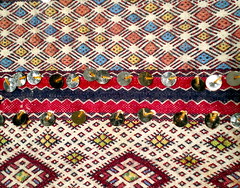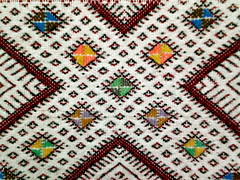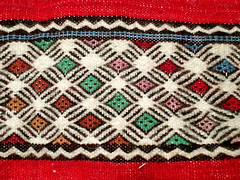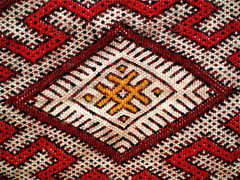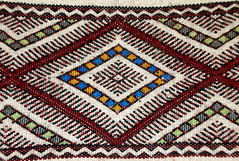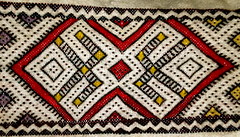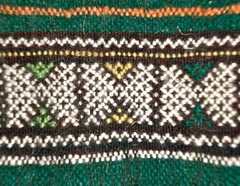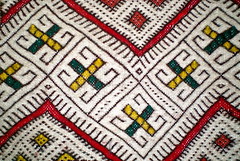The Cooperative des Tisseuses d’Ain Leuh produce detailed pieces that take months to complete. While the High Atlas of southern Morocco and the urban carpets of Rabat are famous for their pile rugs, which are created by tying knots, the Middle Atlas is famous for their flat weavings.
Weavers at the cooperative work on vertical looms, slipping yarn horizontally (the weft) between strands of cotton that are strung vertically (the warp). The weft strands that are woven between the warp are not continuous from edge to edge, and are left hanging to be snipped off after the piece is completed. The yarn is then pounded down with a metal tool to create a tightly woven piece. The weaver sits behind the piece she is creating, working from a pattern that exist only in her mind. Metal sequins, typical to the Middle Atlas region, are sometimes added for decorative purposes.
I’ve learned that the geometric motifs used on the cooperative’s pieces each have a name and are symbols that relate to fertility or protection against evil, or an element in nature.
This common motif (the small and large diamonds) represents the protection against the evil eye.
The frog motif is rarely found in the cooperative’s work.
The spider, snake spine and lion’s paw are evoked on pieces to protect owner from harm.
It is clear these patterns have endured for generations. Take the example of the lion’s paw motif: the barbary lion that once populated the Middle Atlas went extinct over 100 years ago.
Other patterns represent elements of daily Amazigh life.
The saw remains an important tool in the Ain Leuh, where people still heat their homes with wood burning stoves.
Grain is indispensable in making khobs (bread) the #1 staple of the Moroccan diet.
This motif represents the long hair that was the custom among Amazigh men.
This motif is perhaps a bit more modern, representing the cooking surface that is placed over a butane gas can.
In some cases, the original significance of the motif has been lost. For example, the women know this motif is called “tafinzirt” in Tamazight, but don’t know the meaning of the word, or what the motif represents.
Some women like to take artistic license with these traditional motifs to create new designs.
Khadija, however, likes to use the traditional motifs only, saying that she feels like she is connecting with her ancestors and the woman who taught her how to weave when she includes the protective eye, grain, and hair in her work.
I’ve also been doing some reading about the significance of the symbols in Amazigh weavings and came across Berber Carpets of Morocco. The Symbols: Origin and Meaning by Bruno Barbatti. His research-based work argues that the geometric motifs are ancient symbols of fertility. Patterns based on the triangle are feminine. The diamond represents a vagina or womb.
The diamond with extended lines represents a woman ready to conceive, and the small element between the “legs” indicates birth.
Long, straight motifs have phallic signification, and are usually depicted bordering or framing female symbols, indicating sexual union.
Of course, when I read this to the women, they got a good laugh out of this interpretation of their symbols. “The author of that book has got to be a man, right?”
Posted By Laura McAdams
Posted Jul 10th, 2012


